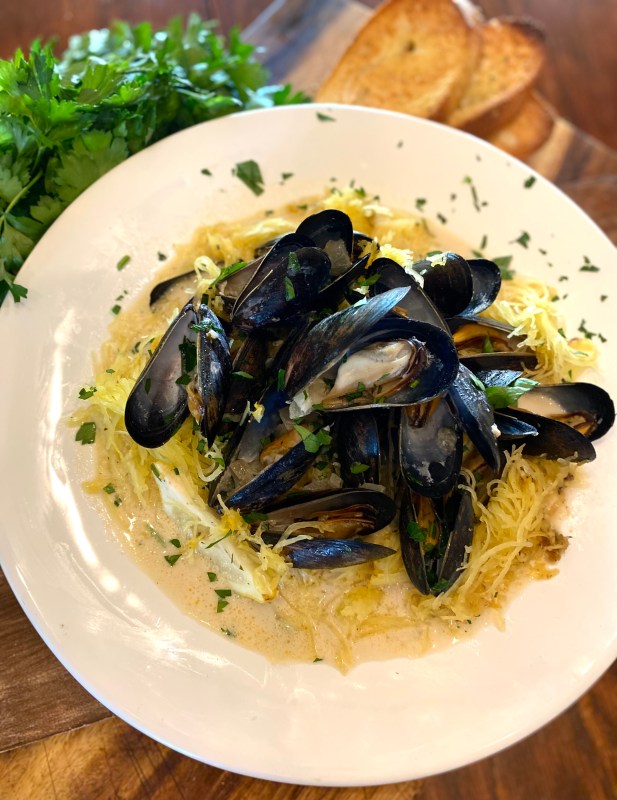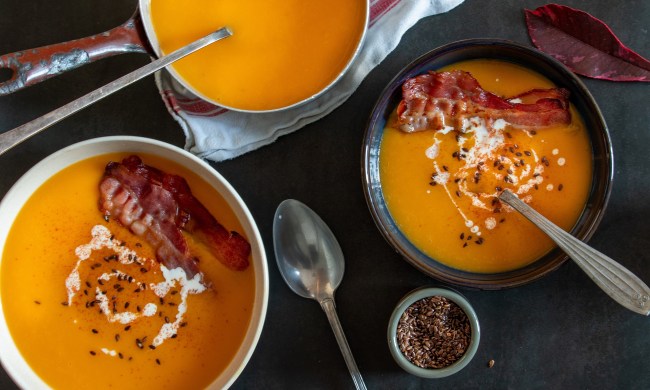When fall foods come to mind, one doesn’t often think of shellfish, but September is when so much of the best seafood comes into season. Mussels are one such treat. A less popular and highly underrated member of the mollusk family, mussels often take a backseat to their more fashionable cousins, like clams and oysters. This is a real shame, because mussels are absolutely delicious, very affordable, easy-to-cook, delectable treats, and you should start eating them asap. They’re also a wonderful source of protein, vitamin B12, and omega-3 fatty acids.
Simply steamed in a bath of white wine, broiled, or grilled, these little delicacies are sure to win you over. Our favorite preparation, though, is served over a bed of another fabulous autumn ingredient — spaghetti squash. When paired together, these two underdogs of the fall food list are a thing of perfection. Spaghetti squash is a delightful alternative to other fall squashes as it not only has a beautifully mild sweetness, but a wonderful, fun spaghetti-like shape.
A few notes on selecting and storing mussels: Always be sure your mussels are fresh (alive), by checking that each one is tightly closed when purchased. The shells should have a nice shine to them, and their scent should be pleasantly salty, like the sea. There should be no trace of a “fishy” smell. You can store your mussels in a bowl in the refrigerator, covered with a damp cloth for up to about a day before cooking.
Spaghetti squash with mussels recipe

This recipe will serve about four…technically. In our experience, though, this dish is so good that the “serving size” isn’t always enough. You may want to double the recipe. Be sure to serve with lots of warm, buttery, crusty bread because the sauce is too good to lose even a drop.
Ingredients:
- 2 large spaghetti squash
- 1 pound of fresh mussels
- 6 tablespoons olive oil, divided
- 1 tablespoon Old Bay seasoning
- 1 teaspoon garlic salt
- salt and pepper to taste
- 1/2 yellow onion, minced
- 2-3 garlic cloves, minced
- 3/4 cup dry white wine
- 1/2 cup chicken stock
- 1/2 cup heavy cream
- 1/4 cup lemon juice
- 1/4 cup parsley, roughly chopped
Method:
- Preheat the oven to 350F.
- Rinse mussels in cold water and set aside.
- Cut both squashes in half vertically, and remove pulp and seeds with a spoon.
- Place all four squash halves cut side up on a baking sheet, drizzle with 4 tablespoons olive oil, and season with salt, pepper, garlic salt, and Old Bay.
- Bake for 1 hour or until squash is fork tender.
- When squash is nearly done, sauté onion in 2 tablespoons olive oil until soft.
- Add garlic and continue to cook until onion and garlic are slightly caramelized.
- Add chicken stock, wine, lemon juice, and cream, and stir to combine.
- Immediately add mussels and cover the pot with a lid.
- Simmer, covered, 5-7 minutes until all of the mussels have opened. Discard any that haven’t.
- While mussels are cooking, scrape the inside of the squash with a fork, mix, and place onto a serving platter. The squash will resemble spaghetti.
- Pour mussel mixture over the squash, garnish with parsley, and serve.
Not only is this dish incredibly delicious, but it’s almost embarrassingly easy to make, very budget-friendly, and impressive enough for guests. So while we all adore a buttery pumpkin soup or warm bowl of chili on a crisp fall evening, why not branch out and try something a little bit different? We’re sure this will be a repeat dish in your fall recipe repertoire.



